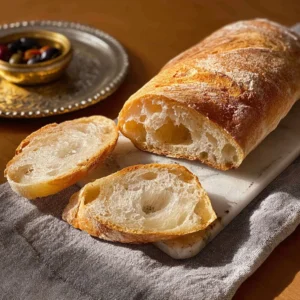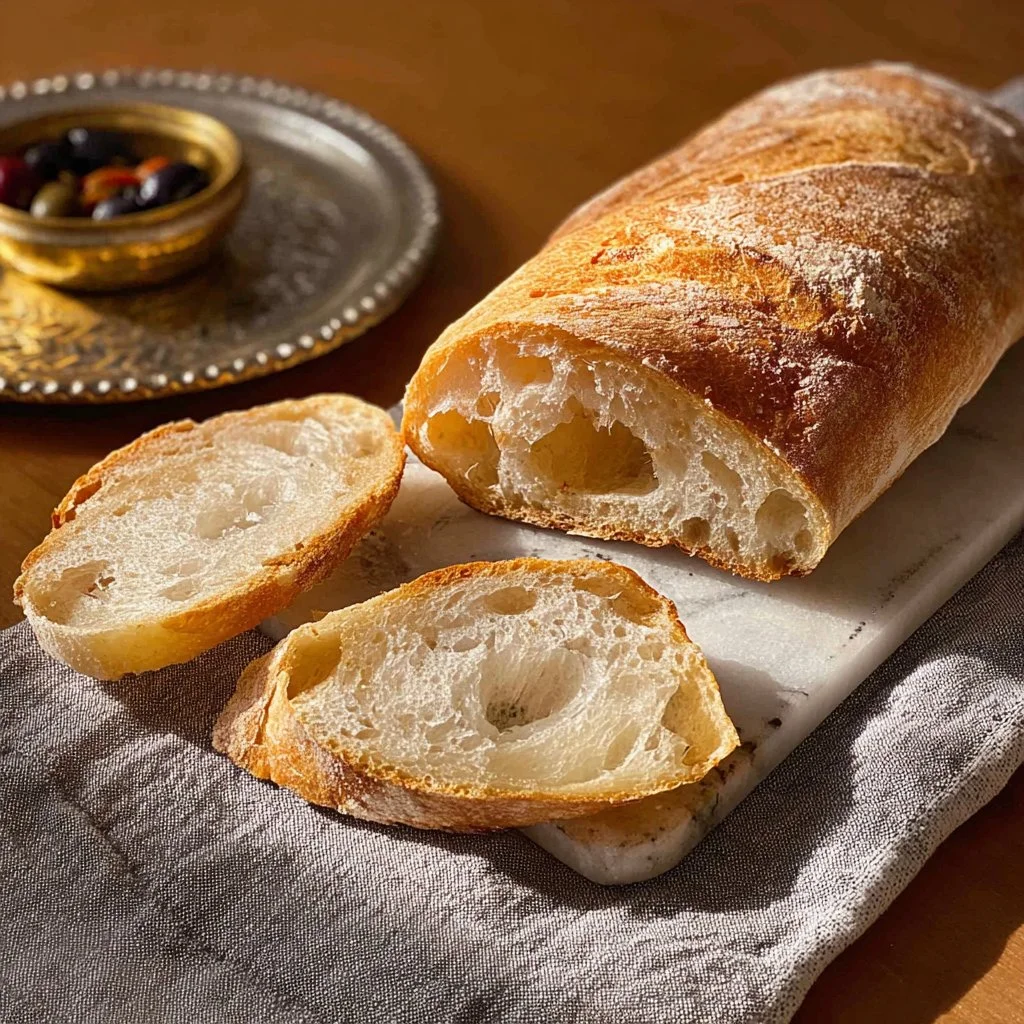Ciabatta bread is more than just a staple in Italian cuisine; it’s a delightful addition to your dining table, known for its rustic appearance and airy, chewy texture. This Italian bread has a lovely crust that contrasts beautifully with its soft interior. If you’ve always dreamt of making your own ciabatta at home, you’re in for a treat. This guide will take you step-by-step through the process, ensuring you achieve the perfect ciabatta loaf that you can be proud of.
Why We Love This Ciabatta Bread Recipe
One of the primary reasons you will adore this ciabatta bread recipe is its straightforwardness. With just a handful of ingredients, you can create a delicious loaf that can elevate any meal. The unique sponge method used in this recipe lends complexity to the flavor, creating a bread that’s full of character. Moreover, ciabatta is incredibly versatile. Whether you enjoy it fresh with olive oil, pair it with cheese, or use it to create a mouth-watering sandwich, this bread will not disappoint. The slight tanginess from the fermentation process adds an extra layer of flavor that is undeniably satisfying. Most importantly, making ciabatta at home allows you to indulge in the culinary experience of bread-making, turning a simple process into a fun and rewarding project.
Ingredients about Ciabatta Bread
For a classic ciabatta bread, you will need the following ingredients:
- 1 cup bread flour (120g)
- 1/2 teaspoon instant yeast
- 1/2 cup warm water (85 to 90°F) (120mL)
- 1 cup warm water (85 to 90°F) (240mL)
- 1 tablespoon olive oil
- 2 2/3 cups bread flour (320g)
- 2 teaspoons salt
These ingredients come together to make a chewy, flavorful loaf that is sure to impress your family and friends.
How to Make Ciabatta Bread Directions
Creating your own ciabatta bread might seem daunting at first, but with this detailed guide, you’ll find it easy and enjoyable. Here’s a step-by-step breakdown to ensure your success:
Prepare the Sponge: Start by taking a medium mixing bowl and whisk together 1 cup of bread flour, 1/2 teaspoon of instant yeast, and 1/2 cup of warm water. The warm water should be around 85 to 90°F. Cover this mixture with plastic wrap or a kitchen towel and allow it to rest for about 3 to 3.5 hours. This waiting period helps develop flavor and texture, setting the foundation for your perfect ciabatta.
Make the Dough: After the sponge has rested, move on to the dough. In a large mixing bowl, combine 1 cup of warm water, the prepared sponge, 1 tablespoon of olive oil, 2 2/3 cups of bread flour, 1/2 teaspoon of instant yeast, and 2 teaspoons of salt. Using a wooden spoon or your hands, mix everything until a shaggy dough forms. It’s okay if it looks a bit messy — a shaggy texture is what you’re aiming for here.
Autolyse: Cover the bowl with a clean kitchen towel and let the dough rest for 30 minutes. This process allows the flour to absorb moisture and relaxes the gluten, making it easier to handle later.
Folding: After resting, it’s time to fold the dough. Perform a total of 8 folds by grabbing one edge of the dough, stretching it upwards, and then folding it over onto itself. Rotate the dough and repeat this fold at each side, resting for 30 minutes in between each set. Do this for a total of three sets. These folds help incorporate air and develop gluten structure, giving the ciabatta its characteristic open crumb.
Cold Fermentation: Next, transfer the dough to a lightly oiled bowl, cover it again, and refrigerate for 8 to 24 hours. This cold fermentation phase greatly enhances the bread’s flavor and texture.
Shape the Loaves: Once the fermentation is complete, it’s time to shape your loaves. Lightly flour your work surface and gently scrape the dough onto it. Be careful not to deflate the dough too much. Fold it into a rectangle and then cut it in half to form two loaves. Transfer the shaped loaves onto a piece of parchment paper.
Second Rise: Allow the loaves to rise for about 2 to 2.5 hours. Ensure they are covered with a clean cloth to prevent drying out.
Preheat the Oven: As your loaves are nearing their rising completion, preheat your oven to 475°F, placing a baking stone or a heavy baking sheet inside to heat up as well. This step creates a hot environment that is ideal for baking bread.
Bake: Carefully slide the parchment paper with the loaves onto the preheated baking stone. Bake them for about 13 to 15 minutes, or until they turn a deep golden brown and their internal temperature comes up to 200°F. The aroma in your kitchen will be utterly irresistible.
Cool: Once baked, remove the loaves from the oven and cool them on a wire rack for about 30 to 45 minutes before slicing. This cooling period allows the crumb to set properly, ensuring a perfect slice.
With patience and practice, you can master the art of making ciabatta bread that rivals any bakery.
How to Serve Ciabatta Bread
Ciabatta bread offers a myriad of serving possibilities. To truly appreciate its flavor and texture, consider the following ideas:
Dipping: Slice your freshly baked ciabatta and serve it with a small dish of olive oil for dipping. Adding a sprinkle of salt and a touch of balsamic vinegar can elevate this simple appetizer.
Sandwiches: Thanks to its rustic crust and chewy texture, ciabatta is ideal for sandwiches. Fill it with your favorite ingredients like grilled vegetables, creamy spreads, or marinated cheese for a meal that’s satisfying and delicious.
Toasts: Transform ciabatta loaves into flavorful toasts. Top slices with avocado, fresh tomatoes, or herbal spreads. You can also use it as a base for bruschetta — simply rub a cut garlic clove on a toasted slice and top it with diced tomatoes, basil, and olive oil.
Salads: Cubes of ciabatta can add a delightful crunch to salads. Toast the cubes until golden and mix them in with greens, vegetables, and your choice of dressing for a unique texture contrast.
Soup Pairing: Serve ciabatta alongside your favorite soup for a filling and comforting meal. The bread’s crusty exterior is perfect for dipping, while the soft interior complements any broth or cream-based soup.
Expert Tips: Ciabatta Bread
Making ciabatta bread is a rewarding process, and with a few expert tips, you can elevate your bread-making game even further:
Use High-Quality Flour: Choosing a flour with high protein content will provide the gluten structure needed for a better rise and chew.
Temperature Matters: Keep an eye on the temperature of your water. Too hot and it might kill the yeast; too cold and it may hinder fermentation. The ideal temperature is between 85 to 90°F for best results.
Be Gentle: When handling the dough, avoid being rough. The air you’ve incorporated is crucial for the structure, so treat the dough gently throughout the folding and shaping processes.
Invest in a Baking Stone: If you want to replicate the temperature and environment of a traditional bread oven, a baking stone is a fantastic investment. It helps retain heat and provides the perfect surface for baking.
Use Steam for a Better Crust: Adding a pan of hot water to your oven during baking can create steam, yielding a crustier exterior. Just remember to exercise caution when adding water to a hot oven.
How to Store Ciabatta Bread
Proper storage of ciabatta bread is essential to maintain its texture and prevent it from going stale too quickly. Here are some effective methods:
Paper Bag Storage: Room-temperature ciabatta bread can be stored in a paper bag. This allows some air to circulate while keeping the crust nice and crisp.
Freezing: If you don’t consume the entire loaf within a couple of days, consider freezing slices or the whole loaf. Wrap it tightly in plastic wrap, and then place it inside a resealable freezer bag. When you’re ready to enjoy, thaw at room temperature or warm it in the oven for a few minutes.
Avoid Plastic Wrap: While tempting, avoid storing ciabatta in plastic wrap at room temperature, as this can lead to a soggy crust and undesirable texture.
Variation of Ciabatta Bread
While classic ciabatta is wonderful on its own, there are several variations you can try to make it your own. Here are a few ideas:
Herb-Infused Ciabatta: Incorporate chopped fresh herbs such as rosemary or thyme into the dough during the mixing phase. This subtle addition can enhance the flavor profile wonderfully.
Cheese-Studded Ciabatta: Fold in small chunks of cheese such as mozzarella or parmesan during the final stages of mixing for a cheesy twist.
Sundried Tomato Ciabatta: Adding chopped sundried tomatoes to the dough creates bursts of flavor in every bite. Pair it with a fresh basil pesto for an unforgettable combination.
Whole Wheat Ciabatta: Experiment with substituting a portion of the bread flour with whole wheat flour. This not only adds a nuttier flavor but also increases the bread’s nutritional content.
Spiced Ciabatta: Mixing in spices like garlic powder, onion powder, or dried chili flakes can give your ciabatta a unique flavor that pairs well with various toppings.
FAQ
What is Ciabatta Bread?
Ciabatta bread is an Italian bread known for its rustic crust and airy interior. It is made using a simple combination of flour, water, salt, and yeast.
How do I achieve an open crumb in Ciabatta?
To achieve that signature open crumb, focus on your folding technique and ensure you’re gentle when handling the dough. Allowing for adequate fermentation also plays a crucial role in developing the structure of ciabatta.
Can I use all-purpose flour instead of bread flour for Ciabatta?
While bread flour is recommended for its higher protein content and gluten development, you may use all-purpose flour. However, the texture may not be as chewy or airy.
How long does it take to make Ciabatta Bread?
While making ciabatta can take a full day due to fermentation and rising times, most of it is hands-off. The active time spent preparing the dough and shaping is relatively short.
Can I make Ciabatta Bread in a bread machine?
Yes! Many bread machines have a dough setting that can be used to make ciabatta. Just follow the ingredient ratios from the recipe, and then proceed to shape and bake the dough after the machine completes the mixing and kneading.

Ciabatta Bread
Equipment
- Mixing Bowls
- Wooden spoon
- Baking Stone
- Parchment Paper
Ingredients
- 1 cup bread flour (120g)
- 1/2 tsp. instant yeast
- 1/2 cup warm water (85 to 90°F) (120mL)
- 1 cup warm water (85 to 90°F) (240mL)
- 1 Tbsp. olive oil
- 2 2/3 cups bread flour (320g)
- 2 tsp. salt
Instructions
- Prepare the sponge by whisking together 1 cup of bread flour, 1/2 teaspoon of instant yeast, and 1/2 cup of warm water. Cover and let rest for 3-3.5 hours.
- In a large bowl, combine 1 cup of warm water, the prepared sponge, 1 tablespoon of olive oil, 2 2/3 cups of bread flour, 1/2 teaspoon of instant yeast, and 2 teaspoons of salt. Mix until a shaggy dough forms.
- Cover the bowl with a towel and let the dough rest for 30 minutes (autolyse).
- Perform a total of 8 folds on the dough, resting for 30 minutes between each set of folds. Repeat for three sets.
- Transfer the dough to a lightly oiled bowl, cover, and refrigerate for 8 to 24 hours.
- After fermentation, gently scrape the dough onto a floured surface and shape it into a rectangle. Cut in half to form two loaves.
- Allow the loaves to rise for 2 to 2.5 hours, covered with a clean cloth.
- Preheat your oven to 475°F (245°C) with a baking stone inside.
- Carefully slide the parchment paper with the loaves onto the preheated baking stone. Bake for 13 to 15 minutes until golden brown and the internal temperature reaches 200°F.
- Cool the loaves on a wire rack for 30 to 45 minutes before slicing.
Send me this recipe!
Just enter your email below and get it sent straight to your inbox!


